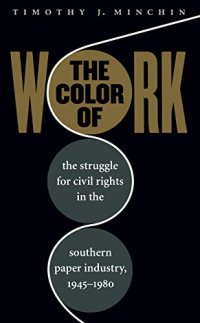
Ebook: The Color of Work: The Struggle for Civil Rights in the Southern Paper Industry, 1945-1980
Author: Timothy J. Minchin
- Tags: Labor & Industrial Relations, Economics, Business & Money, Human Resources, Conflict Resolution & Mediation, Human Resources & Personnel Management, Knowledge Capital, Outsourcing, Business & Money, United States, African Americans, Civil War, Colonial Period, Immigrants, Revolution & Founding, State & Local, Americas, History, African-American Studies, Specific Demographics, Social Sciences, Politics & Social Sciences, Civil Rights & Liberties, Specific Topics, Politics & Government, Politics & Social Sciences, Labor &
- Year: 2001
- Publisher: The University of North Carolina Press
- Language: English
- pdf
Histories of the civil rights movement have generally overlooked the battle to integrate the South's major industries. The paper industry, which has played an important role in the southern economy since the 1930s, has been particularly neglected. Using previously untapped legal records and oral history interviews, Timothy Minchin provides the first in-depth account of the struggle to integrate southern paper mills.
Minchin describes how jobs in the southern paper industry were strictly segregated prior to the 1960s, with black workers confined to low-paying, menial positions. All work literally had a color: every job was racially designated and workers were represented by segregated local unions. Though black workers tried to protest workplace inequities through their unions, their efforts were largely ineffective until passage of the 1964 Civil Rights Act opened the way for scores of antidiscrimination lawsuits. Even then, however, resistance from executives and white workers ensured that the fight to integrate the paper industry was a long and difficult one.
Minchin describes how jobs in the southern paper industry were strictly segregated prior to the 1960s, with black workers confined to low-paying, menial positions. All work literally had a color: every job was racially designated and workers were represented by segregated local unions. Though black workers tried to protest workplace inequities through their unions, their efforts were largely ineffective until passage of the 1964 Civil Rights Act opened the way for scores of antidiscrimination lawsuits. Even then, however, resistance from executives and white workers ensured that the fight to integrate the paper industry was a long and difficult one.
Download the book The Color of Work: The Struggle for Civil Rights in the Southern Paper Industry, 1945-1980 for free or read online
Continue reading on any device:

Last viewed books
Related books
{related-news}
Comments (0)